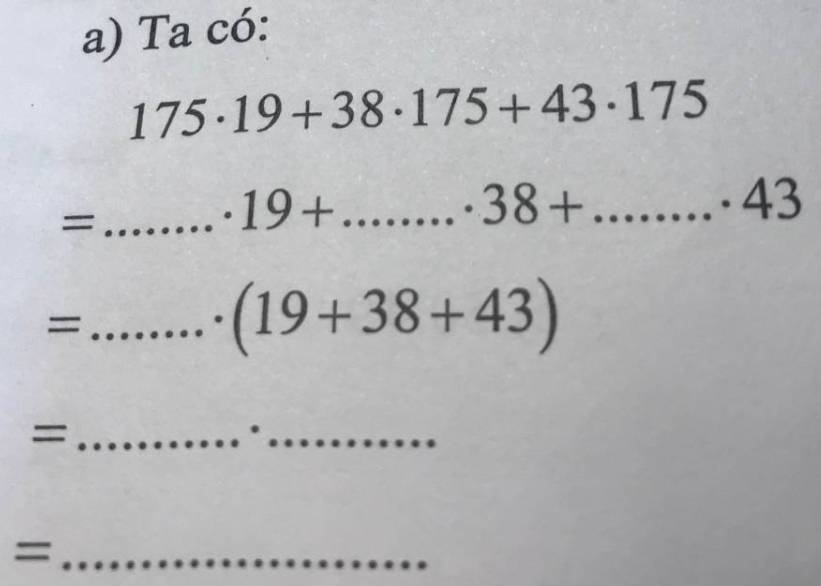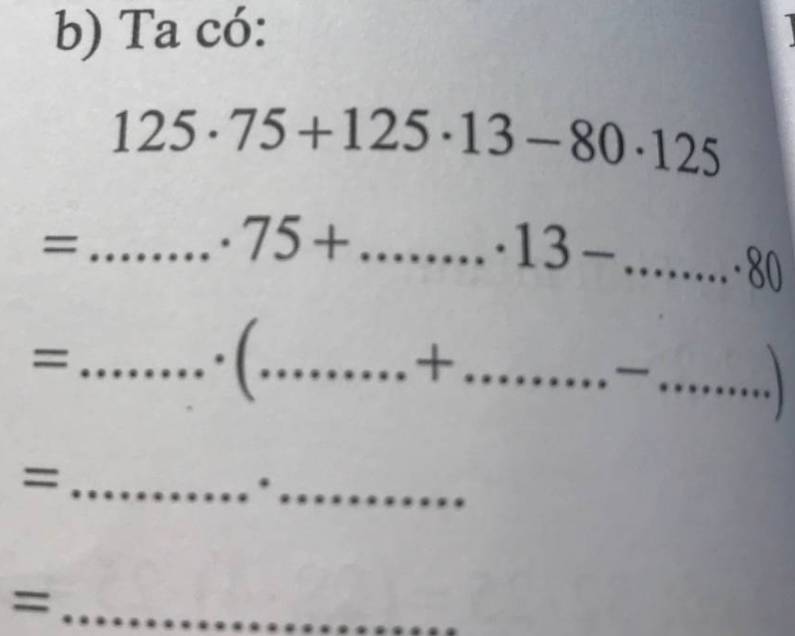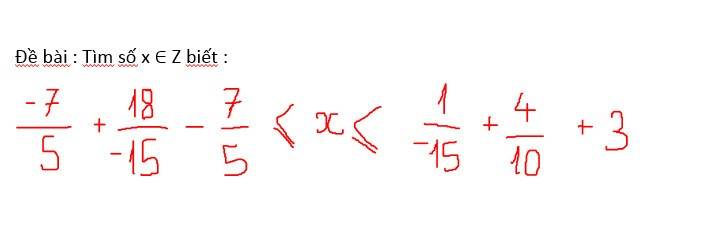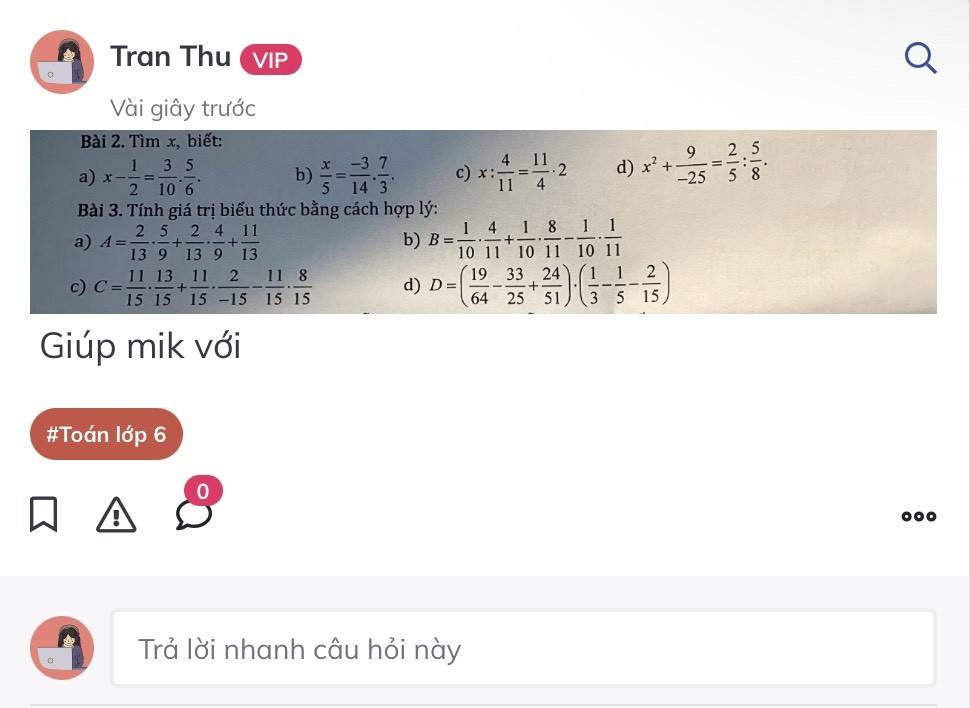
Hãy nhập câu hỏi của bạn vào đây, nếu là tài khoản VIP, bạn sẽ được ưu tiên trả lời.


a)
\(175\cdot19+38\cdot175+43\cdot175\\ =175\cdot19+175\cdot38+175\cdot43\\ =175\cdot\left(19+38+43\right)\\ =175\cdot100\\ =17500\)
b)
\(125\cdot75+125\cdot13-80\cdot125\\ =125\cdot75+125\cdot13-125\cdot80\\ =125\cdot\left(75+13-80\right)\\ =125\cdot10\\ =125\cdot8\\ =1000\)
a, 175. 19 + 38. 175 + 43. 175
= 175. 19 + 175. 38 + 175. 43
= 175.(19 + 38 + 43)
= 175. 100
= 17500

2/
Xét phân số \(\dfrac{2n-3}{n+1}=\dfrac{2n+2-5}{n+1}=\dfrac{2n+2}{n+1}-\dfrac{5}{n+1}=\dfrac{2\left(n+1\right)}{n+1}-\dfrac{5}{n+1}=2-\dfrac{5}{n+1}\)
\(n\in Z\Rightarrow2n-3\inƯ\left(5\right)=\left\{-1;-5;1;5\right\}\)
Ta có bảng:
| 2n - 3 | -1 | -5 | 1 | 5 |
| n | 1 | -1 | 2 | 4 |
Vậy \(n\in\left\{-1;1;2;4\right\}\)
1/
(x + 1) + (x + 3) + (x + 5) + ... + (x + 999) = 500
<=> (x + x + x + ... + x) + (1 + 3 + 5 + ... + 999) = 500
Xét tổng A = 1 + 3 + 5 + ... + 999
Số số hạng của A là: (999 - 1) : 2 + 1 = 500
Tổng A là: (999 + 1) x 500 : 2 = 250 000
Do A có 500 số hạng nên có 500 ẩn x.
Vậy ta có: 500x + 250 000 = 500
=> 500x = -249 500
=> x = 499
Vậy x = 499



\(\dfrac{1}{n\left(n+1\right)}=\dfrac{1+n-n}{n\left(n+1\right)}=\dfrac{n+1}{n\left(n+1\right)}-\dfrac{n}{n\left(n+1\right)}=\dfrac{1}{n}-\dfrac{1}{n+1}\)

Bài 2:
a; \(x\) - \(\dfrac{1}{2}\) = \(\dfrac{3}{10}\).\(\dfrac{5}{6}\)
\(x\) - \(\dfrac{1}{2}\) = \(\dfrac{1}{4}\)
\(x\) = \(\dfrac{1}{4}\) + \(\dfrac{1}{2}\)
\(x\) = \(\dfrac{3}{4}\)
Vậy \(x\) = \(\dfrac{3}{4}\)
b; \(\dfrac{x}{5}\) = \(\dfrac{-3}{14}\) \(\times\) \(\dfrac{7}{3}\)
\(\dfrac{x}{5}\) = \(\dfrac{-1}{2}\)
\(x\) = \(\dfrac{-1}{2}\) \(\times\) 5
\(x\) = \(\dfrac{-5}{2}\)
Vậy \(x\) = \(\dfrac{-5}{2}\);
c; \(x\) : \(\dfrac{4}{11}\) = \(\dfrac{11}{4}\) \(\times\) 2
\(x\) : \(\dfrac{4}{11}\) = \(\dfrac{11}{2}\)
\(x\) = \(\dfrac{11}{2}\) \(\times\) \(\dfrac{4}{11}\)
\(x\) = 2
Vậy \(x\) = 2
d; \(x^2\) + \(\dfrac{9}{-25}\) = \(\dfrac{2}{5}\) : \(\dfrac{5}{8}\)
\(x^2\) - \(\dfrac{9}{25}\) = \(\dfrac{16}{25}\)
\(x^2\) = \(\dfrac{16}{25}\) + \(\dfrac{9}{25}\)
\(x^2\) = \(\dfrac{25}{25}\)
\(x^2\) = 1
\(\left[{}\begin{matrix}x=-1\\x=1\end{matrix}\right.\)
Vậy \(x\)\(\in\) {-1; 1}
Bài 3:
a; A = \(\dfrac{2}{13}\)\(\times\) \(\dfrac{5}{9}\)+ \(\dfrac{2}{13}\)\(\times\)\(\dfrac{4}{9}\) + \(\dfrac{11}{13}\)
A = \(\dfrac{2}{13}\) \(\times\)(\(\dfrac{5}{9}\) + \(\dfrac{4}{9}\)) + \(\dfrac{11}{13}\)
A = \(\dfrac{2}{13}\) \(\times\) \(\dfrac{9}{9}\) + \(\dfrac{11}{13}\)
A = \(\dfrac{2}{13}\) + \(\dfrac{11}{13}\)
A = 1
b; B = \(\dfrac{1}{10}\).\(\dfrac{4}{11}\) + \(\dfrac{1}{10}\).\(\dfrac{8}{11}\) - \(\dfrac{1}{10}\).\(\dfrac{1}{11}\)
B = \(\dfrac{1}{10}\) x (\(\dfrac{4}{11}\) + \(\dfrac{8}{11}\) - \(\dfrac{1}{11}\))
B = \(\dfrac{1}{10}\) x (\(\dfrac{12}{11}\) - \(\dfrac{1}{11}\))
B = \(\dfrac{1}{10}\) x \(\dfrac{11}{11}\)
B = \(\dfrac{1}{10}\)

a) \(\dfrac{5}{11}\cdot\dfrac{5}{7}+\dfrac{5}{11}\cdot\dfrac{2}{7}+\dfrac{6}{11}=\dfrac{5}{11}\cdot\left(\dfrac{5}{7}+\dfrac{2}{7}\right)+\dfrac{6}{11}=\dfrac{5}{11}\cdot1+\dfrac{6}{11}=\dfrac{5}{11}+\dfrac{6}{11}=\dfrac{11}{11}=1\)
b) \(\dfrac{3}{13}\cdot\dfrac{6}{11}+\dfrac{3}{13}\cdot\dfrac{9}{11}-\dfrac{3}{13}\cdot\dfrac{4}{11}=\dfrac{3}{13}\cdot\left(\dfrac{6}{11}+\dfrac{9}{11}-\dfrac{4}{11}\right)=\dfrac{3}{13}\cdot\dfrac{11}{11}=\dfrac{3}{13}\cdot1=\dfrac{3}{13}\)
c) \(\dfrac{-5}{6}\cdot\dfrac{4}{19}+\dfrac{7}{12}\cdot\dfrac{4}{-19}-\dfrac{40}{57}=\dfrac{-5}{6}\cdot\dfrac{4}{19}+\dfrac{-7}{12}\cdot\dfrac{4}{19}-\dfrac{40}{57}=\dfrac{4}{19}\cdot\left(\dfrac{-5}{6}+\dfrac{-7}{12}\right)-\dfrac{40}{57}\)
\(=\dfrac{4}{19}\cdot\dfrac{-17}{12}-\dfrac{40}{47}=\dfrac{-17}{57}-\dfrac{40}{57}=\dfrac{-57}{57}=-1\)
d) \(\left(\dfrac{11}{4}\cdot\dfrac{-5}{9}+\dfrac{4}{9}\cdot\dfrac{11}{-4}\right)\cdot\dfrac{8}{33}=\left(\dfrac{11}{4}\cdot\dfrac{-5}{9}+\dfrac{-4}{9}\cdot\dfrac{11}{4}\right)\cdot\dfrac{8}{33}=\dfrac{11}{4}\cdot\dfrac{8}{33}\cdot\left(\dfrac{-5}{9}+\dfrac{-4}{9}\right)\)
\(=\dfrac{11}{4}\cdot\dfrac{8}{33}\cdot1=\dfrac{11\cdot8}{4\cdot33}=\dfrac{2}{3}\)
e) \(\left(\dfrac{12}{61}-\dfrac{31}{22}+\dfrac{14}{91}\right)\cdot\left(\dfrac{1}{2}-\dfrac{1}{3}-\dfrac{1}{6}\right)=\left(\dfrac{12}{61}-\dfrac{31}{22}+\dfrac{14}{91}\right)\cdot\left(\dfrac{1}{6}-\dfrac{1}{6}\right)\)
\(=\left(\dfrac{12}{61}-\dfrac{31}{22}+\dfrac{14}{91}\right)\cdot0=0\)









Lời giải:
Gọi số thành viên nhóm tình nguyện là $a$. Theo bài ra:
$200< a< 300$
$a-3\vdots 5,6,7$
$\Rightarrow a-3$ là BC(5,6,7)
$\Rightarrow a-3\vdots BCNN(5,6,7)$
$\Rightarrow a-3\vdots 210$
$\Rightarrow a-3\in\left\{0; 210; 420;....\right\}$
$\Rightarrow a\in\left\{3;213; 423;...\right\}$
Mà $200< a< 300$ nên $a=213$
vì số thành viên khi xếp thành hàng mỗi hàng 5 người hoặc mỗi hàng 6 người hoặc mỗi hàng 7 người đều dư 3.
vậy giả sử số thành viên bớt đi 3 người thì sẽ xế vừa đủ vào các hàng. hay nói cách khác khi số thành viên bớt đi 3 người thì số thành viên là bội chung của 5; 6; 7
bội chung nhỏ nhất của 5; 6; 7 là 5.6.7 = 210
vì số thành viên của đội lớn hơn 200 và nhỏ hơn 300 nên số thành viên của đội là 210 + 3 = 213 (thành viên)
đs.......